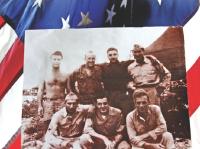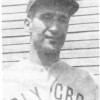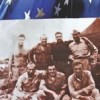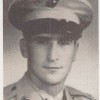 JAMES SCONDRAS
JAMES SCONDRAS
Class of 1938
Inducted in 1987
Another of Lowell High School’s outstanding three sport athletes of the 1930’s, Jim Scondras is remembered for what he accomplished and what he might have accomplished.
Jim competed in football, basketball and baseball for the Red and Gray. He was named first team All-Scholastic as a junior, leading Lowell to the championship of the M.I.T. basketball tournament (the forerunner of today’s state tournament). He captained the 1938 hoop squad. In addition to starring for Lowell High School’s baseball squad, Jim was Captain of the American Legion Post #87 nine that competed in the national championships at Middleton, Ohio, in 1936.
Jim went on to be a three-letter man in football, basketball and baseball at Holy Cross. In 1941, he set a batting record of .457 for the Crusaders in the series against arch-rival Boston College. During the summers of 1941 and 1942, Jim sharpened his baseball skills by playing with Glens Falls, New York, in the northern league. Jim graduated from Holy Cross in 1943.
At this point in his baseball career, many, including his high school coach, Walter Foye, felt that Jim had potential major league ability. Instead, World War II interrupted -and tragically ended–the great athletic career, and worse the vibrant life of an outstanding young man.
Jim, a first lieutenant in the United States Marines, died a hero’s death on February 25, 1945, during the battle of lwo Jima. He received the Purple Heart and Silver Star medals posthumously for his gallantry.
The James Scondras Memorial Gymnasium at the Edith Norse Rogers School in Lowell is named in his honor.
UPDATE:
Sun staff photos can be ordered by visiting our MyCapture site.
From playing field to battlefield, a hero
Jimmy Scondras gave his all for Lowell teams. On Iwo Jima, he gave his life
By David Pevear dpevear@lowellsun.comlowellsun.com
Updated: 11/12/2012
LOWELL – Before he was a hero to a grateful nation, and before generations of Lowell kids came to know his name as a memorial gymnasium, Jimmy Scondras was a hero to Greek boys growing up in the Acre during the Depression.
Some of the boys can still be heard idolizing Scondras weekday mornings at the McDonald’s on Drum Hill Road in Chelmsford, where they meet for coffee. At 83, Charles “Dino” Boutselis’ eyes shine like he again is watching baseball on the North Common in Lowell in the late 1930s.
“Jimmy was up there on that mound pitching, although he was an outfielder (and also a catcher),” Boutselis recalls. “He had that profile. That dark hair. They called him The Chief.”
They called Scondras “The Chief” because his high cheekbones gave him the look of a Native American. “The Chief” fit his considerable bearing. The last time Stephen Ivos, 84, saw his cousin Jimmy, who was 10 years older, was “at his house on Dutton Street. Jimmy walked in wearing his Marine uniform. He looked unbelievable.”
He still looks unbelievable. In stories, Scondras never gets old. He is still the quiet and humble kid making a saving tackle in the mud to preserve a scoreless tie in the 1936 Lowell-Lawrence Thanksgiving Day game, captaining the Lowell American Legion baseball team to the 1936 nationals in Middletown, Ohio, making the All-Tech Tournament team while helping Lowell High to a state title in basketball in 1937.
Leo Panas, 88, who during World War II earned a Bronze Star with the 36th Division in Italy and was later a sports cartoonist for the Lowell Sunday Telegram, makes a point of saying these stories about Scondras were never enhanced to conform to an American military hero. “He was considered a top athlete while he was playing,” Panas emphasizes.
Jimmy Scondras was 25 when he died.
A first lieutenant with the 12th Regiment, 3rd Marine Division, Scondras was killed Feb. 25, 1945 by Japanese mortar fire on Iwo Jima, one of 6,281 Americans killed during a 36-day battle for a heavily fortified hunk of volcanic ash 4 1/2 miles long, 2 1/2 miles wide, strategically located 760 miles southeast of Tokyo.
Sun sports columnist John F. Kenney wrote that upon hearing news of Scondras’ death, major leaguer Frank Skaff from Lowell “could only murmur, ‘The Big Chief … oh no!'”
All these years later, that “oh no” is still felt. Veterans Day allows us to formally thank military veterans for their selfless service and sacrifice. But for many veterans, this is still Memorial Day.
“I think about them every day,” says Ivos, who served in the Army in Japan after World War II and with the Air Force during the Korean War, and whose brother Costas is buried in Lowell’s Westlawn Cemetery near their cousins Jimmy and David Scondras. They were three of the 439 sons of Lowell killed in World War II. So many sobbing mothers, so many what-might-have-beens.
A potential big-league star
His biography for the Hall of Fame at Holy Cross memorializes Scondras’ heroism, and “thus was (he) deprived of pursuing a professional baseball career.”
His Lowell High Athletic Hall of Fame biography says: “Scondras is remembered for what he accomplished and what he might have accomplished.”
Ivos is more certain about what Scondras would have accomplished. “Jimmy would have made the majors,” he says.
Playing for former Philadelphia A’s infielder Jack Barry at Holy Cross, Scondras batted cleanup. In summers, he showed promise playing for St. Albans, Vt., and Glens Falls, N.Y., in the Northern League. Walter Foye, Scondras’ baseball coach at Lowell High, told The Sun in 1945, “That boy would have been top major league baseball timber, had he lived.”
After Scondras’ death, Ivos borrowed a glove his cousin used at Lowell High and Holy Cross. “It had his name in it and everything,” says Ivos, who later played service ball while stationed in Japan. “A beautiful glove.”
But Ivos lost it.
“More than 60 years later, I haven’t lived that down,” he says.
Jimmy Scondras’ lost glove still bothers him.
An era of great talent
The 1930s were rich with Lowell High sports legends. As great an athlete as Scondras was, and even with the gym at the Rogers School dedicated in his memory in 1965, Scondras sometimes is overshadowed by teammates like Ed Murphy and Hank Mazur, who were a year ahead of him at Lowell High. It was a time when sports really did instill character, teamwork and selflessness, words that often ring hollow today amid misplaced ambitions.
Mazur graduated from LHS in 1937 and went on to captain Army’s football team, rushing through West Point in 3 1/2 years so he could fly 83 missions over Europe as a fighter-pilot group commander.
Murphy, 92, a football teammate of Scondras at Lowell High and Holy Cross, received a contract offer from the Pittsburgh Steelers while a lieutenant in the 1st Marine Division heading for the hells of Peleliu and Okinawa.
Scondras graduated from Lowell High in 1938, still probably wiping off the mud from Thanksgiving morning against Lawrence, destined to earn a Silver Star seven years later for conspicuous gallantry in the volcanic ash of Iwo Jima.
According to the citation, Scondras “fearlessly” supported advancing infantrymen who had come under a sudden artillery attack. He “boldly pressed forward against the withering barrage to the top of a steep, jagged cliff where he could better observe the enemy, and, remaining steadfast in this exposed position, simultaneously adjusted and directed accurate artillery and naval gunfire to silence the concentrations and enable the infantry to continue the advance.”
The next day, the American flag was raised over Mount Suribachi. Two days later, Scondras was killed. His Silver Star was awarded posthumously.
Earlier, during the landing on Iwo Jima, three friends from the Acre — Peter Tsapatsaris, Jimmy Tsaffaras and Scondras — had by chance scurried into the same foxhole 7,000 miles from home. The reunion lasted 20 minutes before each hurried off to find his unit. “One of the best guys you would want to get to know,” Tsapatsaris, 91, told The Sun in May while remembering Scondras before being grand marshal of Dracut’s Memorial Day parade.
A commanding athlete
The Sun’s Kenney wrote that Tom Keady, Lowell High’s football coach when Scondras played, once said, “When that youngster hits, something busts.” Scondras’ most famous tackle at Lowell High, though, was a desperate lunge.
In the fourth quarter of a scoreless Thanksgiving Day game in 1936, a Lowell defender slipped in the mud. And a Lawrence runner suddenly had a clear path (albeit a muddy one) to the end zone.
“… And it looked like curtains,” The Sun reported. Then “a mud-smeared end identified only by his headgear as a Lowellite began to close in.” He made a last desperate dive, getting just enough of the Lawrence runner’s heel to trip the Lancer after a 46-yard gain.
“The hero of that incident may well be singled out as the hero of Lowell’s game,” The Sun declared. “He is 155-pound Jimmy Scondras, who played a brilliant game on the flank all morning.”
The game ended 0-0.
The following year, Lowell and Lawrence played to a 6-6 tie. Scondras almost was a hero again. He scored what seemed the winning touchdown on a long pass play. But it was nullified by a penalty against Lowell.
For many years after the war, the Greek American Legion presented the Scondras Trophy to the outstanding Lowell High player in the Thanksgiving Day game against Lawrence. The music would stop and the trophy handed out during a dance at Memorial Auditorium on the Friday night after Thanksgiving.
At Holy Cross, Scondras, a two-way halfback, and team captain Murphy, an end, helped the Crusaders to a historic 55-12 upset of No. 1-ranked Boston College in 1942. The two were in Marine platoon-leader classes while still in school. Athletically speaking, though, Murphy thinks basketball when he thinks of Scondras.
Holy Cross’ basketball program had been launched in 1900 and twice discontinued. In 1939, after four dormant seasons, Holy Cross basketball restarted for good under football line coach “Moose” Krause. “They picked guys from the football team, and had enough guys to have a pretty fair basketball team,” says Murphy.
Scondras was one of those guys, playing on the 1940-41 and 41-42 teams. (Five seasons later, the Crusaders, with a freshman guard named Bob Cousy, were NCAA champs.)
In December 1942, Murphy went to San Francisco to play in the East-West Shrine Game. He remained on the West Coast for basic training at Camp Pendleton. “I later caught up with (Scondras) at Quantico. We were there together. He then went overseas before I did,” says Murphy.
Murphy, who after the war coached Dracut High football for 48 seasons, never saw his teammate again. “After the war I bumped into somebody from his (12th Regiment, 3rd Marine) division and asked if he knew Jimmy Scondras,” he says. “The Marine Corps is not that big. He said, ‘Yeah, (Scondras) was my lieutenant,’ and he told me how Jimmy got killed … awful.”
Lowell’s war sacrifice
The amount of sacrifice is unimaginable to modern Americans. In March 1945, as U.S. troops in Europe approached the Rhine and the fighting raged on Iwo Jima, the photos of smiling young faces from the city appeared daily in The Sun beneath a dreaded headline: “Killed in Action.”
The Sun on March 6, 1945 reported Scondras’ brother David, 20, a private with the 357th Infantry, had died four months earlier in a field hospital in France from wounds suffered in combat. Next to David Scondras’ photo was one of Sgt. Stanley Kyanka, 29, of 205 Rock St., “one of the first men from this city to enlist in the army,” who had been killed in action in Germany on Feb. 19.
On March 15 The Sun reported Pvt. George W. Iversen, of 9 Chestnut St., had been killed in France on Feb. 24. His brother James, a submariner, was reported missing three years earlier and presumed dead. The Sun reported the Iversens to be the third family in this city with two sons killed in the war. But already the Scondras family of 287 Dutton St. was the fourth. The awful news about Peter and Katherine’s son Jimmy (four Scondras brothers fought in World War II) just had not become public.
Shortly before The Sun went to press on Saturday, March 17, 1945, news arrived of Scondras’ death three weeks earlier.
“Ace Athlete Killed on Iwo Jima,” the headline read. “Lt. Jimmy Scondras Follows Brother to Hero’s Grave.”
“Of what are American troops made?” sports columnist Kenney posed two days later. “The life of Jimmy Scondras, whom we knew as one of our own, epitomizes the finest grain of American manhood. This kid was molded the hard way, as so many of the best of ’em are.”
The final trip home
Four years after the war ended, Jimmy and David Scondras, and their cousin Costas Ivos, who was shot down in a B-17 while returning from a mission over Germany in March 1945, finally came home. The flag-draped caskets arrived at the Boston & Maine railroad depot on Monday evening, March 27, 1949. “A whole bunch of us went down to the train station,” says Boutselis. “We walked up to the (Pappas) funeral home where they put the three bodies.”
The Sun reported “thousands” attended the funeral service held two days later at the Holy Trinity Greek Orthodox Church. Hundreds had to wait outside.
“Most of the Greek-American boys lived in the Acre and we all went to the Bartlett School,” says Boutselis. “Joe Duffy was the athletic (coach) at the Bartlett and had watched us all grow up. I remember him out there crying like hell.”
Follow David Pevear on Twitter @merganser10 Copyright 2012 Lowell Sun. All rights reserved. Sun staff photos can be ordered by visiting their MyCapture site.
===========================================================
UPDATE: Article from Holy Cross Magazine, thanks to John Freitas for locating it
http://magazine.holycross.edu/issue_45_2/45_2_sports/45_2_chief
Give Another Hoiah: The Chief Will Never Die, By John W. Gearan ’65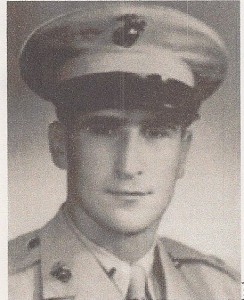
On the morning of Feb. 19, 1945, the U.S. Marines storm the volcano-ash beaches of Iwo Jima, a tiny island with strategically important airstrips that is entrenched with 22,000 Japanese soldiers vowing to fight to their deaths.
Running amid the invasion mayhem, Peter “Red” Tsapatsaris finds shelter from withering machine-gun crossfire by sliding into an enlarged foxhole. Looking up, he sees a very familiar face, Jimmy Tsaffaras, his best friend from Lowell, Mass.
Then, something only Hollywood might invent happens. “A short time later, I see our pal ‘The Chief ’ trudging by,’’ recalls Tsapatsaris, now 89. “‘Hey, over here,’ I yell, and Jimmy Scondras jumps in with us. Imagine three Greeks from The Acre in Lowell, 7,000 miles from home, landing in the same foxhole.”
Impossible to imagine, but true. Sgt. Tsaffaras, First Lt. Scondras ’43 and Cpl. Tsapatsaris grew up in The Acre, an immigrant-springboard neighborhood, then also known as Greektown. All graduated from Lowell High. Because he had high cheekbones and the daring of a Native American brave, his pals nicknamed Jimmy Scondras “The Chief.” They called Tsapatsaris “Red” because of his hair. Scondras ’43 signed on with the U.S. Marines Corps Reserves at Holy Cross. Tsaffaras joined the Marines in April 1942, Tsapatsaris, in November 1943.
Now they are together again, in a foxhole, in mortal danger. The reunion lasts only 20 minutes. “Jimmy (Tsaffaras) put together a quick meal for us from a can of scrambled eggs,” recalls Tsapatsaris.
“Then ‘The Chief ’ and I are off to find our units.’’ Lowell, a proud industrial mill city along the Merrimack River less than an hour northwest of Boston, is in the limelight these days. It serves as the backdrop for the Oscar-nominated film The Fighter, a familiar story of an impoverished pug punching his way to a boxing crown. Mark Wahlberg plays “Irish” Micky Ward, who battles back to win a 1991 alphabet-soup championship while overcoming emotional entanglements with his dysfunctional family. The well-done bio-flick is causing a pleasant buzz in Lowell. Everyone seems to know Micky Ward, who still runs a boxing gym there. They are basking in his fame, however ephemeral.
But even along Highland Street, where his name still graces the entrance to a community gymnasium, hardly anyone asked recognizes the name of James P. Scondras.
Though Scondras’ heroic deeds are part of Lowell lore, you have to visit places like The Owl Diner and the Greek American Legion in The Acre to hear older folks speak, with reverence, about “The Chief.”
Scondras grew up during the Depression, living on the edge of The Acre at 287 Dutton Street. His Greek immigrant parents, Peter and Katina, somehow supported their eight children by running a small downtown restaurant, The Busy Bee, on Merrimack Street.
“The Chief ” achieved athletic stardom early on. As a Lowell High sophomore he hit .400 and stole eight bases in 20 games. As a junior he sparked Lowell to a state basketball championship in the old Tech Tourney. As a senior, Scondras scored eight touchdowns as a starring halfback; as basketball captain, he led the team in scoring; in baseball, he hit .345 while leading the team in triples, homers and runs batted in.
“Jimmy was terrific at everything he tried,’’ says Stephen Ivos, his first cousin. “He could play every position in baseball, football and basketball. He was a champion diver for the YMCA swim team.” His athletic resume glitters: Captain and catcher for the American Legion team that played in the 1936 National Championship Tournament in Middleton, Ohio; his stellar play for the city football champs, the Blackhawks; and his baseball feats in the Greater Lowell Twilight League and, for Glens Falls, N.Y., in the Northern League.
A natural leader. Handsome, humble and on the quiet side. Yet very social and quite a dancer. Took a part in the senior class play. Always active in his church. “Everybody loved the guy,” says Ivos, fighting back tears after all these years.
After a year at St. John’s Prep in Danvers, Mass., The Chief arrived at Holy Cross ready to make his mark as a Crusader sensation.
“He’s a player’s player and this year has only scratched the surface of his ability,’’ crowed The Tomahawk student newspaper in January 1941 about the three-sport standout. In his second year on The Hill, Scondras impressed as a hard-nosed two-way halfback in football. As a starting guard, he helped re-launch the Holy Cross basketball program under Coach Ed “Moose” Krause, sparking the Crusaders’ upset over hosting Amherst College before 1,800 fans on Lincoln’s Birthday, 1941.
That baseball season, under the immortal Coach Jack Barry ’10, Scondras hit cleanup. At packed Fitton Field before a homecoming crowd, Holy Cross trounced Boston College, 11-2, in the final game of the 1941 season. Wrote Roy Mumpton of the Worcester Telegram, “The old grads cheered loudly as Jim ‘Chief ’ Scondras shattered a 1-1 tie with a tremendous three-run triple in the third inning … and their din crescendoed as the Lowell sophomore followed this decisive hit with three straight singles and hoisted his batting average to an almost unbelievable .471.”
In his third and fourth years, Scondras excelled as a versatile two-way halfback whose teams nearly stunned Boston College (14-13 last-minute loss) in 1941 and then shocked the Eagles in a historic 55-12 upset before 40,000 fans at Fenway Park. In basketball, he sparked a thrilling 47-45 victory over Brown University, scoring eight points to energize Holy Cross’ fourth-period comeback. His hitting keyed baseball victories over Harvard, Yale and Boston College in a war-shortened 1942 season.
But World War II had to be fought. In the spring of 1943, fourth-year student Scondras became one of the first in his class to sign on with the Marine Reserves, joining a team called the Third Division.
When Scondras left that foxhole on the beaches of Iwo Jima, he knew all too well the grave danger of his task. Seven months before, in Guam, on D-Day (July 21, 1944), Scondras had already been cited for acts of heroism after crawling to the top of a rocky ridge and lobbing a hand grenade into a Japanese machine nest, silencing it.
As a forward observer with his artillery unit, Scondras would have to scout out the enemy, concealed in caves and tunnels, and direct incoming firepower. According to a citation accompanying his Silver Star Medal, “On Feb. 22, 1945. First Lt. Scondras boldly pressed forward against the withering barrage to the top of a steep jagged cliff where he could better observe the enemy. From this exposed position, he directed artillery and naval gunfire to silence Japanese attacks and allow the infantry to capture the airstrip.”
The next day, the Marines erected the American flag atop Mount Suribachi, an emblematic act memorialized by a now famous photo and a bronze sculpture at Arlington National Cemetery.
Two days later, First Lt. Scondras was struck by mortar fire and killed. “His radioman was badly wounded by the same shell that killed Jimmy,’’ says Red Tsapatsaris. “The radioman and I were in beds next to each other on a hospital ship. He told me about Jimmy’s terrible death. We couldn’t stop crying.”
First Lt. Scondras was buried on Iwo Jima near the base of Mount Suribachi, his grave among others marked by a simple white cross. On March 29, 1949, Scondras’ body was brought home for interment in Lowell’s Woodland Cemetery along with that of his brother David P. Scondras, an Army infantryman who died in action in France in November 1944. Their gold-star mother and father stood at Lot 154 with family and friends for the burial ceremony. The Chief ’s Marine buddies from the foxhole, Jimmy Tsaffaras and Red Tsapatsaris, were there, too, wearing their medals received for their courage and wounds suffered on Iwo Jima. They all grieved the deaths of the Scondras brothers and their first cousin, Costas Ivos, buried in an adjacent plot, and remembered the 36 other sons of Lowell killed during World War II.
Tsapatsaris, one of six children, retired after a long career as a proofreader for book publisher Courier Corporation. Tsaffaras, one of nine children, died at age 89 in 2009, after a distinguished career as a Lowell police officer. A new gymnasium was dedicated in Scondras’ name in 1965. Every Thanksgiving, the Scondras MVP trophy is presented at the Lowell-Lawrence football game. In 1986, Scondras was enshrined in the Lowell High Hall of Fame. And, in 1990, The Chief gained entry to the Holy Cross Varsity Club’s Athletic Hall of Fame.
“‘The Chief ’ will never die,” says Tsapatsaris. “He will always be Lowell’s shining star.”
John W. Gearan ’65 was an award winning reporter and columnist for the Worcester Telegram and Gazette for 36 years. He resides in Rhode Island.
Graduation/Class Year: 1938
Gender: Male
LHS Sports Played: Baseball, Basketball, Football
LHS Sports Coached:
LHS Teacher or Admin:
LHS Sport Captain: yes
Living/Deceased: Deceased
College: Holy Cross
Graduate School:
Professional/International/Olympic Sports:
Nickname: "The Chief"
Coach-Other Organization:
Other Halls of Fame: Holy Cross Varsity Club's Athletic Hall of Fame
Military Service: U.S. Marines
Political Office:
Other:
Additional Features:
[slickr-flickr tag=”Scondras” flickr_link=”on” sort=”title” direction=”ascending”]
